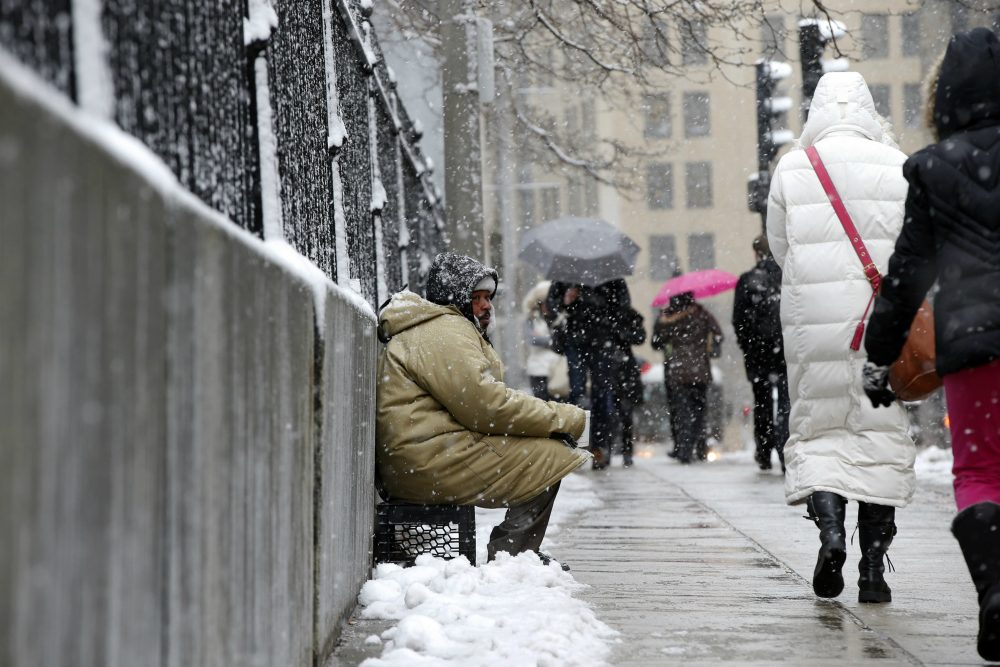Advertisement
A Prescription To Treat Homelessness In Boston, Threatened

COMMENTARY
It was 3 a.m. and 3 degrees outside, and I was about to discharge Mike from our Emergency Department for the third time in less than 24 hours.
"Doc, let me finish this episode," he said, his eyes glued to the TV in the ER waiting room.
Mike was homeless, and this was our routine all winter last year, when it was too cold to sleep in shop doorways or the bridge under I-93. Many times he was drunk, and we monitored him until he was sober enough to be discharged. Other times he would fabricate medical issues that needed to be evaluated, excuses that kept him safe and warm, at least for a few hours.
What should be the role of emergency departments in caring for homeless patients with no emergent medical needs? Emergency departments nationwide don’t have a good answer to this question.
That morning, he came in intoxicated. Another physician evaluated him for signs of injury. There were none. When he sobered up, he was discharged with a thick stack of papers detailing the dangers of alcohol abuse.
Later that day, Mike came back in complaining of pain in his foot. Another exam, another discharge.
About 30 minutes later, I saw Mike amble in and park himself back in the chair from which he had just been discharged.
This time it was pain in his knee. Mike didn't need emergent evaluation. He came in because it was freezing outside, the T wasn’t running, and the shelters were too far away.
Last winter our Emergency Department saw hundreds of patients like Mike. Boston’s annual homeless count last January tallied 1,732 individuals in emergency shelters. Hundreds more slept on the street.
The truth is that for folks like Mike, we are their de facto shelter, a hotel with infinite vacancies.
But patients like Mike put a real financial strain on the system. One recent analysis that tracked 35 of Boston's high utilizers like Mike found that they accounted for more than $3.6 million in costs at a major Boston hospital over just an eight-month period.
What should be the role of emergency departments in caring for homeless patients with no emergent medical needs? Emergency departments nationwide don’t have a good answer to this question. Nor do emergency physicians have either the time or the training to wrestle with this question on a busy shift. Instead, we grapple with the reality we’re handed.
How long can we keep him in this warm examining room until another patient needs it? How many shelters will I have to call until one tells me that they have room? How do we get him to that shelter four miles away in sub-freezing temperatures?
"Let me just rest here,” Mike said when I offered to get him into a shelter that night. “I ain't gonna be back here for awhile, anyway."
"Why is that?" I asked.
“They're getting me a place in Dorchester,” he said.
Surprised, I asked how.
"HUES program," he responded, eyes not budging from the TV screen.
In 2011, Boston made a bold step to help patients like Mike. It created the High-Utilizers of Emergency Services (HUES) to Home program.
It supports homeless individuals who are habitual users of Boston's emergency services by providing them with case management, links to substance abuse and mental health counseling, and, most importantly, it connects them to permanent housing.
HUES to Home is working. For example, after receiving housing, one patient who had visited the ER 50 times the year before didn’t go to the ER once in 10 months. Another patient suffering from alcohol abuse was housed in a single-room occupancy apartment for nine months; his ER visits dropped from 90 to 12.
But too many remain unserved.
Like many of the programs that care for the city's poor, disabled and frail elderly, HUES to Home is in desperate need of expansion. It also, like many of the programs that serve these vulnerable populations, partly relies on a fragile funding source: Medicaid.
That's why providers statewide rejoiced when, on Nov. 4, Massachusetts received permission from HHS, called a waiver, to overhaul the way it pays for health benefits through Medicaid. With that waiver was a promise of $52 billion in funding beginning in 2017 over five years.
For providers, this felt like the cavalry riding to our aid in our campaign to care for the vulnerable.
Four days later, on Election Day, it seemed that cavalry had been recalled.
...after receiving housing, one patient who had visited the ER 50 times the year before didn’t go to the ER once in 10 months.
President Trump and House Speaker Paul Ryan have proposed giving states a block grant for Medicaid, rather than using the current funding formula.
This could mean a cut of up to a third of current Medicaid funding.
That reduction would jeopardize programs that protect vulnerable patients -- programs like HUES to Home, which gave Mike a way to escape the cold, and which also saves the system money.
Now more than ever, we must be committed to putting patients over politics. Protecting Medicaid funding is one place to start.
